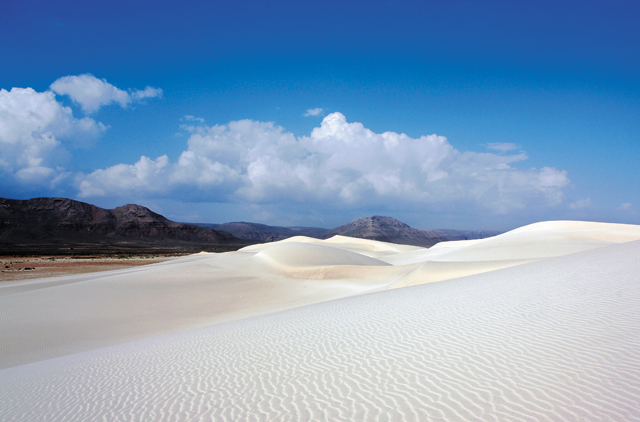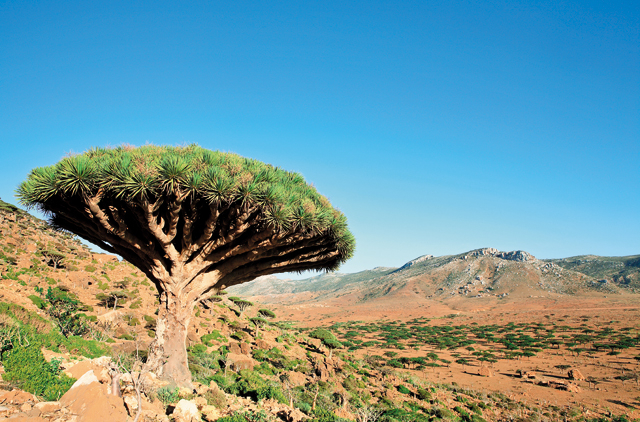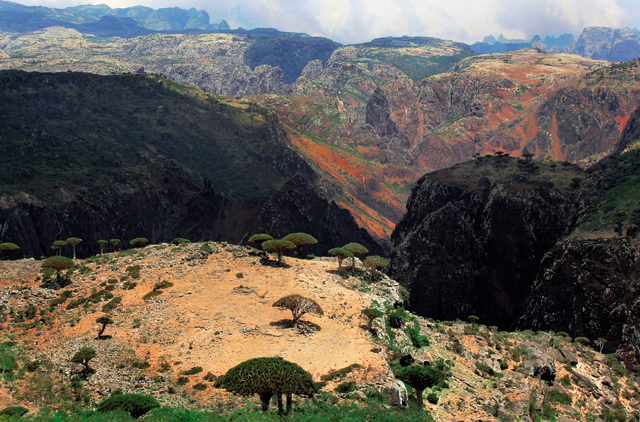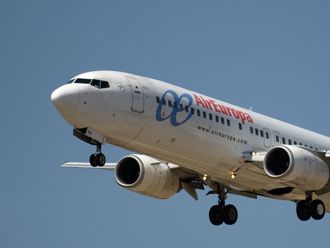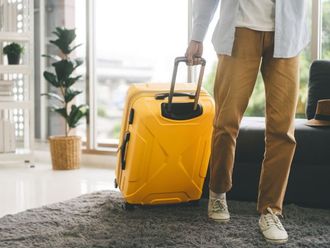
It lies around 1,500km from the southern tip of the UAE – closer to Abu Dhabi than parts of Pakistan and Iran – yet to all intents and purposes it might as well be on the other side of the planet.
On a world atlas the island looks like a pebble dropped into the Indian Ocean. It lies just off the Horn of Africa, closer to the coast of Somalia than Yemen, which it is officially part of.
Until a few years ago, there was no commercial airport, making it effectively sealed off from the modern world, forgotten to all but the most determined botanists, attracted to its unique flora which has developed over centuries in light of the island’s isolation. The island was inaccessible for several months every year due to the harsh monsoon winds which prevented all but the hardiest boats from crossing from the mainland.
In the second half of the last century, the island remained off limits. Friends of mine living in Aden, the capital of the People’s Democratic Republic of Yemen, could not get permission to visit it.
The island I’m referring to is the archipelago of Socotra, or Soqotra, as many well acquainted with the island prefer to spell it (as this spelling is closer to what some believe to be the Arabic origin of the name: Suq Al Qutra meaning: ‘Island of Liquid Drops’.) Once I made it to the island, I felt blessed to have reached its shores. Let me share some of my experiences there with you…
The lure of the remote
It was the extreme isolation of the island that initially appealed to me. As an inveterate, slightly jaded traveller, Soqotra’s remoteness gave it a magical allure. But just like St Helena, the exiled location of Napoleon in the South Atlantic and other similar inaccessible islands in the Pacific, I dreamt wistfully about visiting, but never really thought I would make it there.
Soqotra has been visited by traders for millennia. Its frankincense – of which there are eight local species endemic to the island – was coveted in Ancient Rome. The burgundy-coloured resin which gives the unique, umbrella-shaped dragon’s blood trees (dracaena cinnabari) their name, was used as a dye for centuries. Local folklore tells us that in ancient Egypt, Cleopatra used Soqotran dragon’s blood resin to redden her lips, a custom that is continued by women on some parts of the island.
A string of fateful events
My decisive moment was when I visited a Middle Eastern book store while I was in London. I was attracted to a picture of towering dragon’s blood trees on the cover of a book entitled The Lost World of Socotra: Yemen’s Island of Bliss (Richard Boggs: Stacey International: 2009). ‘No harm in the imagination having a bit of a run’, I thought, and bought the book to read on my way back to Dubai. It turned out to be a fateful decision.
After racing through the book, I started to make a few enquiries and things moved quickly. The fact that a friend of a friend had actually been there and had been shown around by a wonderful local guide confirmed that permission was no longer required to visit the beautiful archipelago.
More research led me to the Felix Airways website, a Yemeni airline that flies daily from Sana’a to Soqotra via the former trading hub of Mukalla on the Hadhramaut coast.
Fast forward to a couple of months later and the problem no longer stands as to how to visit the island. The problem the island now faces is how to ensure that a potentially huge influx of tourists eager to discover new ‘unspoilt’ destinations doesn’t disturb its fragile ecosystem and unique cultural heritage.
My guide for my stay, Mohammad, is a man devoted to his ancestral heritage. He has a lot of views regarding sustainable tourism and is actively involved in numerous projects driven at keeping Soqotra’s heritage and ecosystems intact. Many are in wide agreement that the island should promote eco-tourism and heritage programmes rather than the pristine beaches. The hope is to attract the kind of tourist who will be respectful of the island’s natural habitats and heritage sites. A balance between conservation, sustainability and economic development is imperative.
The third fateful event – and the trip had barely begun – was the Felix flight itself. Meeting up with Mohammad in Sana’a, we boarded the plane bleary-eyed for departure at 6am. Pulling out my Soqotra book, I asked Mohammad if he had come across it. I was slightly taken aback when he lunged at it, telling me excitedly: “Richard is a great friend of mine. He was my mentor here. This book is full of our adventures and my stories.” He went on to tell me that not only was the book replete with photos of his friends and family, but that we would no doubt meet a number of them during my stay on the island. Meanwhile, unbeknown to me, Mohammad had a quiet word with the steward, and before take-off
I was invited to meet Captain Hassan Baharoun and his copilot Ahmad Al Gunaid, who invited me to return to the cockpit with my camera, buckle up, and join them for much of the flight to Mukalla. They regaled me with their running commentary. It was not something I’ve done on any flights to Europe, so it was a memorable start to the journey. Everything about this trip seemed to be falling nicely into place.
A hearty welcome
At Soqotra airport half the island seemed to have come out to greet Mohammad, who had been away for a few weeks. Within minutes we were squeezed into a pick-up and winding our way along the coastal road to Hadibu, the capital of the island. We passed quirky desert roses, frankincense and cucumber trees. No sooner had we arrived at my sleepy little hotel than Mohammad called out to a man across the street, “Rashid, come here, I’ve got a photo of you”. He then turned to me and said: “Mike, find the picture of this guy. He’s the one carrying the goatskin full of dates”. Picture duly pointed out, I was amused as I took a photo of Rashid looking at the photo of himself in Richard Boggs’ book.
The sun was already high in the sky the next morning as I wandered down to the shoreline and through alleys of stone and coral houses sunk into the sand. I was reminded of the traditional dwellings in Zanzibar and Mombasa. It wasn’t something I expected in Yemen.
I stopped at the local souq where I was immediately invited to join a group of young mainlanders enjoying a lunch of harees – or hareesh as it is known in Yemen. The guys were impressed that I knew the name of the creamy, wheat-based dish they were eating, which is accompanied by a spicy salsa – zahawig – and a fenugreek dip.
After a brief nap (my time on the island was too short to indulge in long siestas) I took a trip along the coast to inspect the ruins of a Portuguese fort. I was then invited to Mohammad’s home for a simple but delicious meal of tuna steaks and tomato saloona with fresh, home-baked bread.
Blue hues
It’s an early start the next morning for a leisurely drive along the north coast to the town of Qalansiyah. We stopped along the way to buy frankincense on the side of the road. This aromatic resin is no longer harvested commercially.
I ran my finger over the thick, treacle-like resin. The scent lingered on my fingers for the next two days. In Qalansiyah we obtained permission from an army outpost to climb a hill which, from the top, affords the most stunning vista of a brilliant, powder-white sand bank separating the sea from a lagoon, offering up the most beautiful blues and turquoises in contrast to a backdrop of shimmering sand.
We were offered a delicious lunch of fresh caught tuna and kingfish in a bed of tasty rice. Wholly satisfied, we lounged in the open majlis of the stone courtyard with a cup of sweet tea. This is sustainable tourism at its best.
The children in the compound are the picture of health, scampering around, challenging me to take their photo while sucking on limes. There are no crisps or candy here. The place is pristine – not a scrap of plastic or rubbish in sight.
Dragon’s blood trees on the Diksam Plateau
Another day and another set of adventures. We climbed the Diksam Plateau, a central range of mountains separating the north from the south of the island. It is here that I first encounter the iconic symbol of Soqotra: the dragon’s blood tree. I am excited to see my first one, which is over seven metres and resembles an upturned shaving brush. A fully-mature one is surprisingly tall and broad, like a colossal mushroom or cauliflower floret.
he tree is the most well-known out of the 300 species endemic to the island. The crystallised sap oozes naturally from underneath the bark every four years and is used as a medicine and dye to this day.
The island seems to offer up new delights at every turn. Mohammad reserves the most pleasant surprise for the end of my stay. He invites me to visit his family who live in a small cluster of stone houses on an escarpment. After making our way up the gradual incline for an hour or so, stopping for a swim in the wadi on the way, we park the car under a shady tree and take in the green valley that extends for miles below us. We make the final 100-metre climb to the village (comprising three houses) called Tsaberhan, which means ‘little tamarind tree’ in the Soqotri language.
A night under the stars
A warm welcome awaits us and I find the hospitality quite moving. Mohammad’s family are friendly, kind and attentive; curious but slightly reserved. The young boys in the village are fascinated by the pictures in the book of themselves and the family camel, who is particularly photogenic.
Two baby goats are slaughtered in our honour, and a fascinating age-old custom of hospitality unfolds. Every piece of the goat is brought in turn before us, the prime pieces being offered to the guests.
It would be early-lights-out in the village if there actually were any lights, but electricity is not likely to reach the village for some time. So we unroll our sleeping bags in the flickering of an old oil lamp.
Gazing up at the stars, I catch a few shooting across the night sky. There is only the occasional chirp of a cricket to be heard through the night calm. The peace was interrupted in the early hours of the morning. I was jolted awake by what appears to be a series of guttural shouts and cries from all directions.
From one side came a throaty ‘cak-cak-cak’ and from another, a bone-tingling series of low growls, sounding all too similar to a disgruntled bear. I crawled deeper into my sleeping bag.
At sunrise, one of Mohammad’s nephews, dressed in his uniform, rucksack on his back and ready for his two-hour walk to school, came over to us with a bowl of fresh goat’s milk and freshly-baked bread. Mohammad apologised for forgetting to inform me that the members of his family rise early. The sounds I’d heard before had come from the village men who rise before dawn and summon – in their own individual and distinctive ways – the goats to come in from all corners of the mountain.
All good things come to an end
It was with great reluctance that I rolled up my sleeping bag and left the village and its warm people. The return flight stopped in Mukalla and Aden before reaching Sana’a where I spent a night before making my connecting flight to the UAE. While writing several days later, gazing at my 900-plus photographs, I am transported back to those beautifully isolated, remote and peaceful shores of Soqotra, the island of liquid drops.
(Real Flavours of Arabia by Mike Harrison has a chapter devoted to Yemeni food and is available at leading bookstores in the UAE.)


